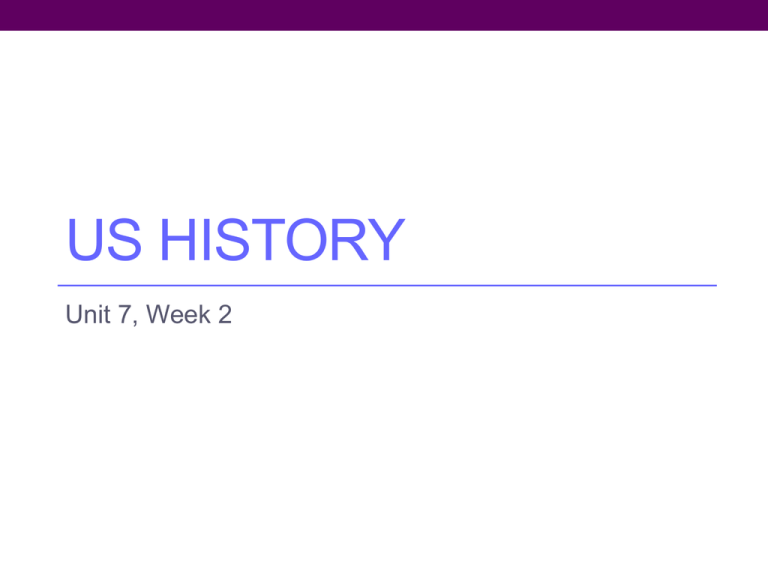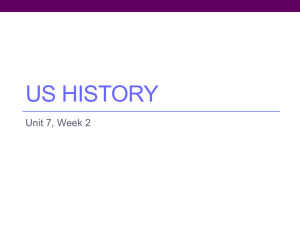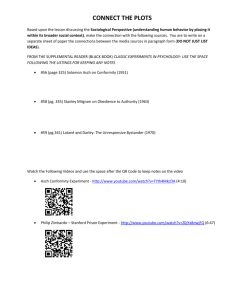US History - Mountain View-Los Altos Union High School
advertisement

US HISTORY Unit 7, Week 2 Homework for the Week • Monday 2/4 • Video link and questions: • Watch the following video link: http://www.youtube.com/watch?v=IKqXu-5jw60 • Read the following pages: 523-525 • Respond to the following Questions • Evaluate the effectiveness of the video • If you were a business owner, how could you use the Atomic Age trend to market a new product? • Was the FCDA justified in making a “preparedness” campaign in order to ensure the safety of the American people or was it simply a scare tactic to maintain conformity? Thesis statement • Block Day 2/5 & 2/6 • Cornell Notes, pgs 558-561 • Instead of an analysis at the end, create a thesis statement responding to the following prompt: Identify the reasons while poverty still persisted in the age of affluence. • Thursday 2/7 • Catch up on missing HW. Unit Test on Tues, 2/12 • Friday 2/8 • Put together your notes checklist • Study vocab Monday 2/4 • Agenda • HOT ROC • Homework check • HOT ROC: Dot Game • New Vocab: McCarthyism and service sector • Reminders • Test corrections Tuesday and Wednesday at lunch HOT ROC • Read the 2 explanations of the US in Guatemala and highlight key phrases in the readings. Reasons in favor of US involvement in Guatemala Reasons against US involvement in Guatemala 1. 1. 2. 2. 3. 3. Homework Check • Pgs. 510-513 • Was US intervention and covert action overseas justified? • Additional questions • What is the definition of a Third World country? Give an example • Should the US pick and choose which developing countries it aids or should we help everyone? • Was it appropriate for the US to intervene in Egypt? • Are economic reasons a valid justification for covert actions? Ex. Guatemala. HOT ROC: The Dot Game • Object of the Game: • To begin the game, you will receive a slip of paper. Secretly check to see whether the paper is blank or has a red dot. Then hide it in your pocket and do not show it to anyone during the game. • Nondots win the game by forming the largest group of students who are all nondots. • Dots win the game by being the only dot in a group. • Procedure: • You can ask others whether they are dots or nondots, but players may not reveal their slips of paper during the game. • You do not have to join a group, but you cannot win the game unless you are in a group of at least two people. • You can be a part of a group only if that group agrees that you are a member. • If you suspect that someone is a dot, report your suspicion to the teacher. He or she will deal with the accusation appropriately. Dot Game: Communist Hysteria of the 1950s The Dot Game Analysis: Make historical connections to the dot game from pages 520-522. Dot Game Some students were dots Most students were nondots Students accused others of being dots even though they never saw other students’ slip of paper Students were to report suspected dots to the teacher. Anxiety increased as students lost trust in one another. Historical Connection Homework • Watch the following video link: http://www.youtube.com/watch?v=IKqXu-5jw60 • Read the following pages: 523-525 • Respond to the following questions • Evaluate the effectiveness of the video • If you were a business owner, how could you use the Atomic Age trend to market a new product? • Was the FCDA justified in making a “preparedness” campaign in order to ensure the safety of the American people or was it simply a scare tactic to maintain conformity? Thesis Statement Block Day 2/5 & 2/6 • Agenda • HOT ROC • Homework Check • Writing Activity • Rebelling Against Conformity • Video (If time) • Homework • Cornell Notes, pgs 558-561 • Instead of an analysis at the end, create a thesis statement responding to the following prompt: Identify the reasons while poverty still persisted in the age of affluence. HOT ROC • Analyze the video: http://www.youtube.com/watch?v=5mGTLrI8rxQ&feature=related • What is the message of the video and how does it relate to the 1950s? • What is conformity? How is conformity perceived as positive and how can it be perceived as negative? • New Vocab: Suburbia Homework Check • Video link and questions: • Watch the following video link: http://www.youtube.com/watch?v=IKqXu-5jw60 • Read the following pages: 523-525 • Respond to the following Questions • Evaluate the effectiveness of the video • If you were a business owner, how could you use the Atomic Age trend to market a new product? • Was the FCDA justified in making a “preparedness” campaign in order to ensure the safety of the American people or was it simply a scare tactic to maintain conformity? Writing Instruction • Share your thesis with your neighbors • Was the FCDA justified in making a “preparedness” campaign in order to ensure the safety of the American people or was it simply a scare tactic to maintain conformity? • Share as a class. Discuss organizational categories Rebelling Against Conformity • Necessary Items: Textbooks and you may use colored pencils or pens for this activity. • Think about the “Little Boxes” video. Copy the following diagram onto two facing pages of your notebook. Inside the Box Instructions • We will listen to two songs from the 1950s, for each song, complete the following: • Identify if it belongs inside the box or outside of the box. • Put the name of the song in the appropriate location • What is the message of the song? What lyrics can you quote that convey that message? • Write down a few lyrics that demonstrate the message of the song in the appropriate location. • Song 1: Shake, Rattle, and Roll (1954) *Bill Haley Version • http://www.youtube.com/watch?v=Wa4FH9mbDGU • Song 2: Summertime Blues (1958) • http://www.youtube.com/watch?v=y1uYK8yILTQ Instructions Sections 41.1 & 42.2 • Inside the box, list four positive characteristics of 1950s’ suburbia • Outside the box, list four reasons why critics did not like suburbia Section 42.3 • Read the subsection “Beats Defy Convention in Poetry and Literature.” Outside the box, create and draw a symbol of the beat movement and label it Beats. • Next to the symbol, list at least three characteristics of the beats and beat literature. • Read the subsection “Rebellious Teens Create a Youth Culture.” Outside the box, create and draw a symbol of the youth culture and label it Youth Culture. • Next to the symbol, list at least three characteristics of the youth culture. • Read the subsection “Comic Books Deviate from ‘the American Way.’” Outside the box, create and draw a symbol of a comic book and label it Comic Books. • Next to the symbol, list at least three characteristics of comic books and the movement against them. • Read the subsection “Artists Rebel with Paint.” Outside the box, create and draw a symbol of abstract expressionism and label it Abstract Expressionism. • Next to the symbol, list at least three characteristics of abstract expressionist artists and their art. Processing • Choose one of the options below to answer the Essential Question: • How did some Americans rebel against conformity in the 1950s? 1. Write a beat poem. • Your poem should be at least eight lines. 2. Write a 1950s rock ’n’ roll song. • Your song should have at least three verses. 3. Draw the cover of a comic book. • Include a one paragraph written description of how your comic book cover answers the Essential Question. 4. Create an abstract piece of art. • Include a one paragraph written description of how your art answers the Essential Question. Video (if time allows) • 1953-1960 Happy Daze • Part 1: http://www.youtube.com/user/CenturyAmericasTime#p/u/26/xRShq 4Bht7E • Part 2: http://www.youtube.com/user/CenturyAmericasTime#p/u/27/Xa4DN qsKmFs • Part 3: http://www.youtube.com/user/CenturyAmericasTime#p/u/28/x7CHz sv23rE Thursday 2/7 • Agenda • HOT ROC • Homework Check • 1950s group activity: Peace, Prosperity, and Progress. • Homework: • Catch up on missing HW. Unit 7 test on Tues, 2/12. HOT ROC • You will follow along to a simple instructional guideline on the following slides. As you do, make note of what the instructions demonstrate about gender roles of the 1950s. • Refrain from commentary, we will discuss your opinions afterwards. The Good Wife's Guide From a 1950’s Home Economics high school textbook • Have dinner ready. Plan ahead, even the night before, to have a delicious meal ready on time for his return. This is a way of letting him know that you have be thinking about him and are concerned about his needs. Most men are hungry when they get home and the prospect of a good meal is part of the warm welcome needed. • Prepare yourself. Take 15 minutes to rest so you'll be refreshed when he arrives. Touch up your make-up, put a ribbon in your hair and be fresh-looking. He has just been with a lot of work-weary people. • Be happy and a little more interesting for him. His boring day may need a lift and one of your duties is to provide it. • Clear away the clutter. Make one last trip through the main part of the house just before your husband arrives. Run a dust cloth over the tables. • During the cooler months of the year you should prepare and light a fire for him to unwind by. Your husband will feel he has reached a haven of rest and order, and it will give you a lift too. After all, catering to his comfort will provide you with immense personal satisfaction. • Minimize all noise. At the time of his arrival, eliminate all noise of the washer, dryer or vacuum. Encourage the children to be quiet. • Be happy to see him. Homework Check • Cornell Notes, pgs 558-561 • What is the poverty line? • Who are the working poor? • How were the poor often “invisible”? • What was the intention of urban renewal? What actually happened? • How did agribusiness hurt small farmers? • What was the termination policy? • We will spend more time on the issue of poverty in America on Friday. • Instead of an analysis at the end, create a thesis statement responding to the following prompt: Identify the reasons while poverty still persisted in the age of affluence. Station Activity: Chapter 41, Peace, Prosperity, and Progress • Distribute worksheet • You will be divided into six stations. Follow the directions on your worksheet for each station. • After 5 minutes, you will rotate to the left to another station. • We will debrief at the end of class (or Friday). Station 1: 41.2 Postwar Politics: Readjustments and Challenges • Read the following article: http://countrystudies.us/uni ted-states/history-115.htm • What were the goals of Truman’s Fair Deal? • What worked? • What didn’t? • Look at pg. 534 in the textbook. How was the Taft-Hartley Act an attempt to stop the progressive reforms of the Fair Deal? Station 2: 41.3, Economic Growth Creates an Age of Affluence • How are each of the following items examples of encouraging consumption? • Advertisement: http://www.youtube.com/watch?v=m7t9YlMxWoE • Buy Now, Pay Later: http://books.google.com/books?id=pto5xnJXvkC&pg=PA6&lpg=PA6&dq=credit+card+1950s&source=bl&ots=bsrz0rhjds&sig=Rz6wOPPxq1VRfn2iPUIAVuzTM4E&hl=e n&sa=X&ei=IjIMUZWKMqS2iwLCl4GwBg&ved=0CJQBEOgBMA0#v=onepage&q=credit%20card%201950s&f=false • Planned Obsolescence: http://pactlab- dev.spcomm.uiuc.edu/drupal/2011cmn280/node/8954 • Blue Collar & White Collar • Read the section on page 539 titled “The Workforce Shifts from Blue- to White-Collar Jobs” • Why did the shift take place? • What is an example of a blue-collar job? • What is an example of a white-collar job? Station 3: 41.4 Marriage, Families, & a Baby Boom • Watch the following video clip: http://www.youtube.com/watch?v=wT_A9PFOY18 • What was life like for the middle class? • What was the “baby boom” • What was the expectation for middle class women? • *If time: http://www.youtube.com/watch?v=D-I-sYNuLq0 Station 4: 41.5 Population Shifts to Suburbs and Sunbelt States • Analyze the images provided • Why was there a shift from the “Rust Belt” to the “Sunbelt” in the 1950s? • Why are the regions of the US called the “Sunbelt” and “Rustbelt”? • Use page 543 for help (if necessary) Station 4: 41.5 Population Shifts to Suburbs and Sunbelt States Station 4: 41.5 Population Shifts to Suburbs and Sunbelt States Station 4: 41.5 Population Shifts to Suburbs and Sunbelt States Station 5: 41.6 The Triumph of the Automobile • Watch the following video clip: • • • • • http://www.youtube.com/watch?v=W7-m3FEm5VA What are three reasons for the emergence of a “car culture” in the 1950s. What did they look like? How was owning a car a status symbol? How did President Eisenhower justify the Interstate Highway Act? What types of activities and job opportunities became possible as a result of the car? Station 6: 41.7, Technological Advances Transform Everyday Life • Use the images provided and the following links to respond to the questions: • Link 1:http://www.ehow.com/info_8086895_medical-discoveries1950s.html • Link 2: http://cr.middlebury.edu/es/altenergylife/nuclear.htm • How did technological advancements change life for the American people? Give three specific examples. Station 6: 41.7, Technological Advances Transform Everyday Life Station 6: 41.7, Technological Advances Transform Everyday Life Friday 2/8 • Agenda • HOT ROC • Poverty in America Lesson Plan • Homework • Study vocab • Reminder • Vocab Quiz on Monday • Test: Friday 2/15 HOT ROC • Share your future plans (Homework from last night) • Reflection: What do you want to do as a career in the future? How will you accomplish your career goal? Draft a plan for the next 10 years of your life. • What resources will you need to help you accomplish your goals? • What resources are available to you simply because you live in Mountain View or Los Altos? • New Vocab: Inner City Lesson Plan Activity: How would you teach Ch. 43? Objective: Draft a PowerPoint presentation that would help students to understand and remember the key ideas from Ch. 43. • Step 1 - Break up into groups of 3-5 people • Step 2 – Reviewing the content. • What is a good way to categorize the information in this chapter? • Do you want to divide up the information the way it has been done in the textbook or can you come up with a better way to sort the information? • Make notes on the key information from the chapter and how you’d put this onto a slide. • Step 3 - Create a HOT ROC that goes with your content. It can be a question or an activity. • Step 4 - Sketch out what layout and graphics you’d want to use. Keep in mind that there are lots of different ways to do a slide layout (ex. You can include graphic organizers or photos) • Slide 1 – HOT ROC • Slide 2-4 Key information from the chapter • Slide 5 (and 6) - What activity can help students engage with the content? (compare/contrast, cause and effect, connect to prior knowledge, simulation) • Would you want to add a video clip? What would an ideal video clip be? What pictures would you include?



